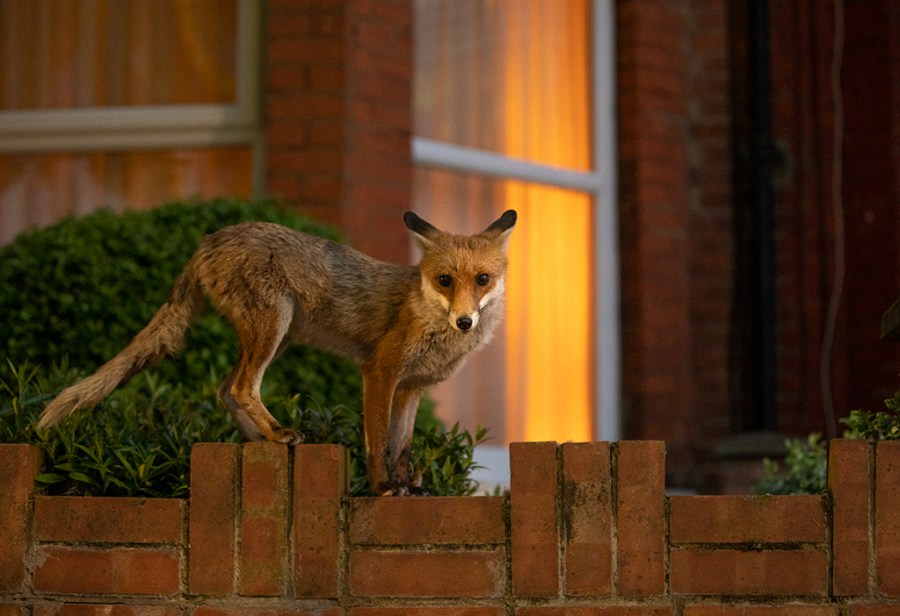Wildlife photographer Matt Maran haunts London photographing our nocturnal neighbours – the beautiful and clever red fox. Keith Wilson finds out how he gets such striking photos below
Just over five years ago, on a cold Boxing Day evening in 2016, wildlife photographer Matt Maran and his partner stepped outside their north London home to walk off some of their excess Christmas indulgence. Moments later they turned a corner into a street they hadn’t explored before and by chance witnessed two foxes, both on their hind legs, scrapping with each other on a small green.
Quickly, Matt ran back home to get his cameras but by the time he returned the foxtrot was over and the two participants had vanished. At the time, Matt was trying to decide which wild animal to document for a long-term project. This unplanned encounter with the urban red fox provided the answer. ‘I went back the next night and the night after,’ he recalls, ‘and because these foxes were just hanging around on this green and it was just a ten-minute walk away, I thought this was perfect.’
Matt recognised the potential of his new-found wildlife location and returned most nights to photograph his chosen subjects, trying to get acquainted with their habits and behaviour patterns. Foxes are mostly nocturnal, so much of his work has been done at night, and he freely admits to making many mistakes in those early days.
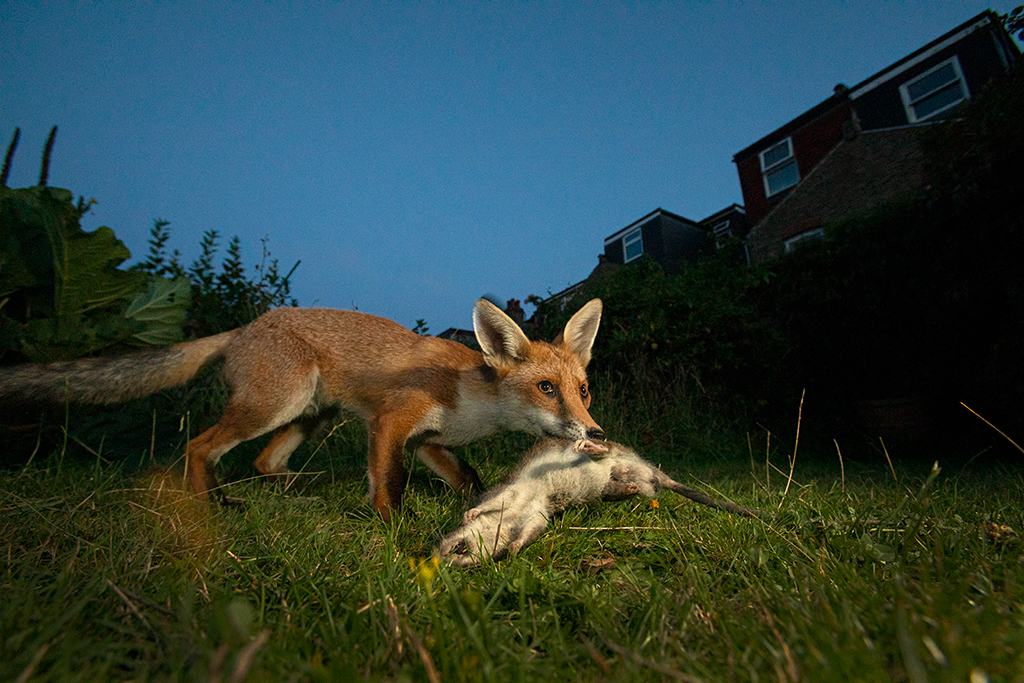
The fox and the rat. Canon EOS 5D Mark III, EF 16-35mm f/2.8L USM at 16mm, 1/100sec at f/8, ISO 3200, two EX flashguns, off camera, remote trigger
‘In the beginning, I went out with one flash mounted on the hot shoe and quickly learnt it’s much better when it’s off the hot shoe and you’re lighting it more subtly from the side,’ he says. ‘You don’t want to blitz the animal, you almost want to recreate the street light on the fox’s face. The best-looking images of urban foxes are the ones that don’t look like they’ve been lit by flash, it could almost be street light as well.’
Allotment access
Six months after that initial Boxing Day encounter, Matt gained access to a nearby allotment where he was told a family of foxes lived relatively undisturbed. It proved to be a major turning point as it allowed him to observe the foxes on a daily basis. More importantly, he gained the trust of the animals as they became used to his frequent visits. By now, the lighter summer evenings meant he didn’t always have to resort to flash.
‘When I got access to the allotment and it was getting lighter in the evenings I would only use natural light. That was definitely easier.’ However, there was one piece of behaviour that Matt wanted to capture, which still required the use of flash and a remote trigger. ‘When the sun went down the foxes would often stay on the allotment for a bit and that’s when I got shots of them drinking from these water troughs.’
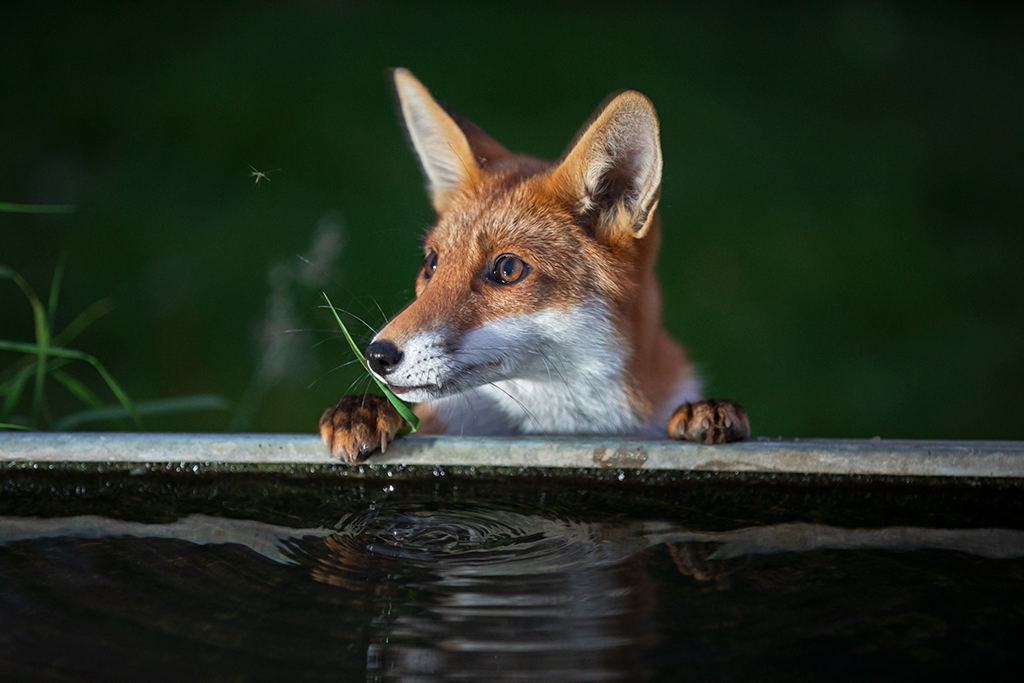
The fox and the mosquito. Canon EOS 5D Mark IV, EF 70-200mm f/2.8L IS II USM at 190mm, 1/40sec at f/2.8, ISO 3200. Two EX flashguns, off camera, remote trigger
The shot above was taken in almost complete darkness and reveals the moment a fox looks up from drinking to see the tiny form of a mosquito. Both the fox and the mosquito are in focus and their movement frozen by the flash burst. ‘That moment was 100% luck,’ says Matt. ‘There’s no way you could anticipate for that, and then the lens is wide open at f/2.8 so the focus plane is incredibly narrow.’
A moment of luck
The presence of the mosquito may have been luck, but Matt had planned this shot meticulously, spending many weeks observing how the fox would position itself on the water trough to drink. He explains, ‘What they would always do is they’d leap up onto their hind legs, put their front paws over the edge and lap up the water.’
To perfect his set-up he made many practice shots, adjusting his focus, lighting position and exposure settings. ‘I had two flashes on that particular set-up, a camera, a tripod, with a 70-200mm set back from a water trough. Most of my efforts were failures. I’ve got loads of pictures of me pretending to be the fox with my hands over the edge of that water trough!’
Matt firmly believes that practice and fieldcraft creates its own luck, but it is the years spent observing one particular vixen, now six years old, that has provided him with many of his most memorable photos, including this wideangle portrait (above right), which required him to lie on the ground and wait for her to appear. ‘They are creatures of habit, just like us,’ he says. ‘I followed her the most.
She would do territory rounds, she would do food rounds, so I got to learn which gardens she would go in, and I would go ahead of her, prepare myself, get my settings right. On that occasion she just came out and stopped, which is rare, because they are always on the move. That was a pleasing moment, this character portrait of a fox. As far as she’s concerned she’s in her territory, these are her front gardens.’
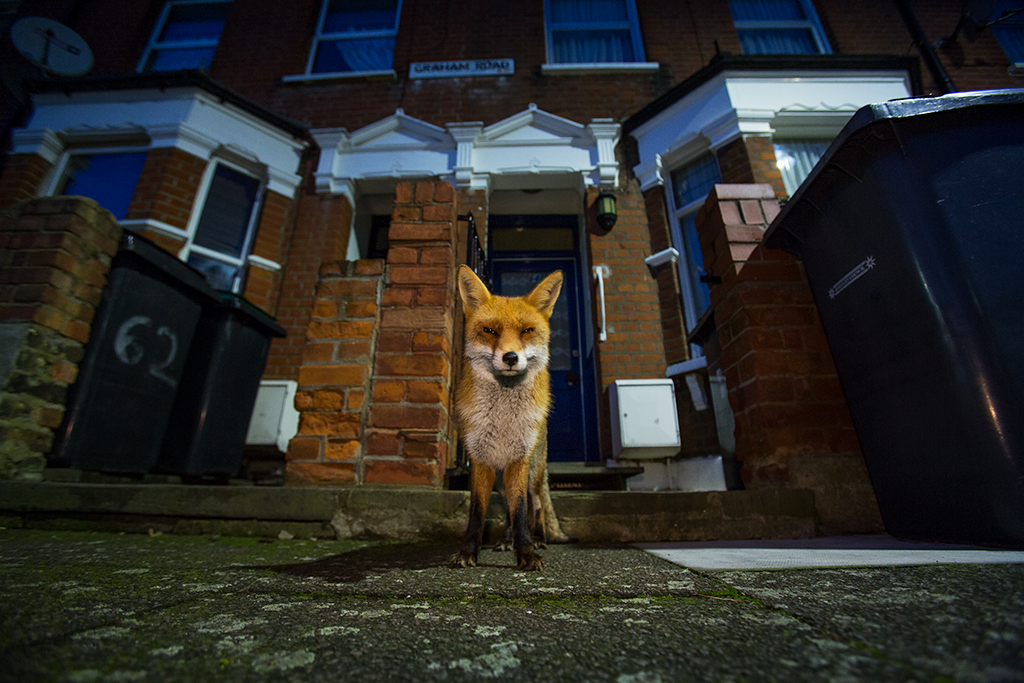
The fox out front. Canon EOS 5D Mark III, EF 16-35mm f/2.8L USM at 16mm, 1/15sec at f/3.5, ISO 1600, single flash
Fieldcraft and subject knowledge
A busy city street might not seem like your typical wildlife location, but the same principles of knowing the location and your subject in order to get the best images apply just as strongly, including for the night-time antics of urban foxes. While out walking one night, Matt noticed the familiar form of the vixen walking just ahead of him. ‘I knew where she was going, she does her normal routes, including running past this particular shop, but on this occasion she just went in there, and I couldn’t believe it,’ he says.
Fortunately, Matt had his Lumix S1 and 50mm f/1.4 lens with him, his preferred combination when shooting handheld at night with available light, the ISO often rated at 5000. He only had time to fire three frames. ‘There was no flash on this, just all ambient light but there was enough light coming out of the shop. The first two shots were a shambles, but then it was a case of adjusting the
aperture, it was quite bright, so bringing it down a little bit, and then firing as she was turning.
I think it was the only one where she was sharp. I just wish she had a bag of Walker’s in her mouth as she left the shop!’
Top tips for photographing foxes at night
Work close to home
Find somewhere that’s easily accessible and nearby that you can return to ‘over and over again’, says Matt. ‘Any city in the UK now has urban foxes. By revisiting a location you learn the lie of the land, where the light falls, and eventually predict their behaviour.’

Talk to neighbours
Ask your neighbours whether they have seen foxes nearby. ‘That’s how I gained access to the allotment,’ says Matt. ‘Relationship building is not something that’s often talked about in photography, but you might get access to someone’s garden who has foxes.’

Get support where you can
Matt tries to avoid using tripods to stay mobile, so he will improvise. ‘I’ll use my camera bag or I’ve got a little beanbag filled with lentils, but usually I’m lying around on the streets of London, on my belly, getting dirty. God knows what I’m lying on!’
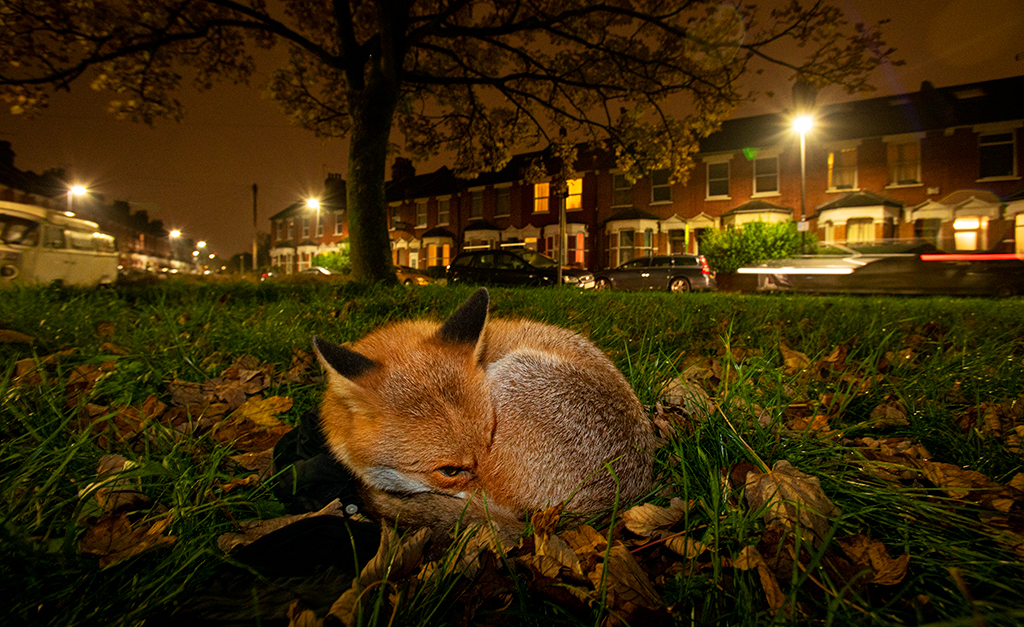
Flash control
Controlling the level of flash output is vital. ‘Don’t go right up and blitz the fox at the first attempt. I’ve learnt to turn the power right down on the flash to give it more of a natural feel.’ Low power also reduces the risk of overexposing the fox’s white front.

Crank up the ISO
A high ISO in ambient street lighting, or mixed with low flash output, can produce excellent exposures. ‘High ISO is definitely a game-changer in low light. When you haven’t got the chance or ability to use flash, then crank up your ISO and don’t be afraid to do it.’
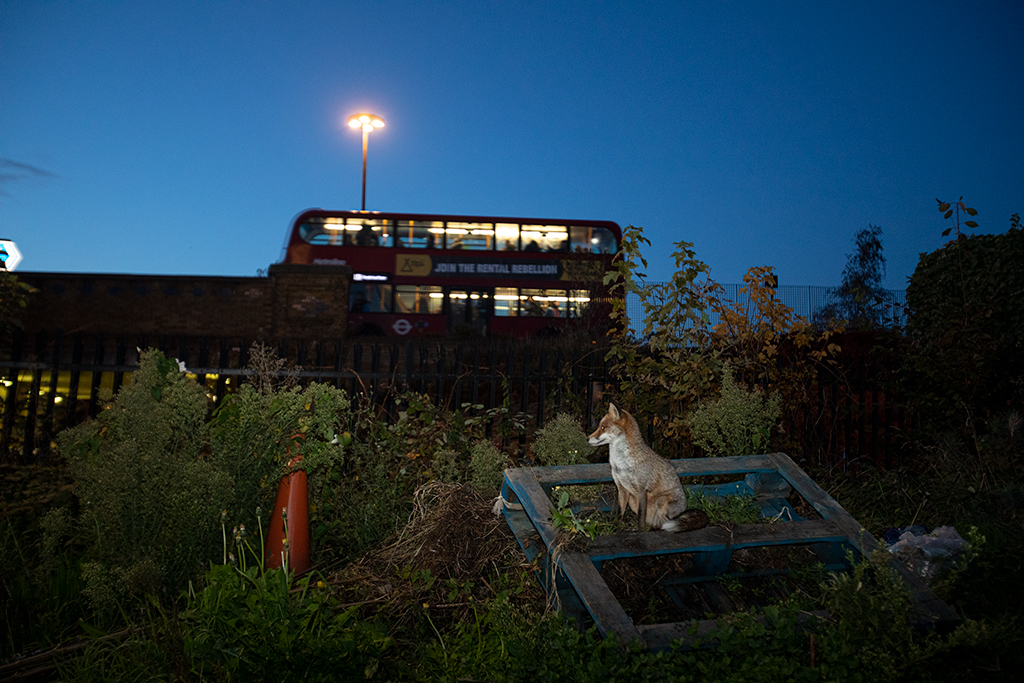
Develop a soft touch
Foxes are skittish, but low powered or diffused flash won’t scare them. ‘If you get enough to put a catchlight in the eye and take out some of the shadow in the face it makes such a difference to the depth and quality of the picture,’ says Matt.

Kit List for photographing the red fox and other nocturnal wildlife
Canon EOS 5D Mark IV
Matt uses both Canon and Lumix camera systems, but the Canon is his preferred option for camera trap and remote flash photography. He favours either one of two lenses for his night fox work, the EF 16-35mm f/2.8L USM or EF 70-200mm f/2.8L IS II USM (used in this shot on the right).
Off-camera flash
Matt has three Canon flashguns to choose from: the 680 EX-RT II, 580 EX and 430 EX II. For this and most of his flash photos he uses two flashguns, off camera. ‘It is so much better having two flashes rather than one, coming from either side, both set to really low power.’
Remote trigger
Remote triggers allow Matt to still be on location and observe, but far enough away to remain unobtrusive. ‘I use a Pocket Wizard,’ he says, ‘So I’m standing away from the camera. When these animals are drinking, they’re vulnerable, so the further away you can be, the more likely it is that they’ll exhibit natural behaviour.’
Tripod
A Manfrotto tripod with Arca Swiss ball head is Matt’s choice of tripod. ‘I don’t like using tripods, I find them limiting. Obviously, with camera traps you have to, because if you’re leaving your camera on an overnight set-up, it’s usually with a low shutter speed.’
Matt Maran

As a seasoned pro, Matt’s images have appeared in the UK press and National Geographic, as well as winning awards in Wildlife Photographer of the Year, the British Wildlife Photography Awards and more. Visit matthewmaran.com, @mattmaranphoto on Twitter and Instagram, and /matthewmaranphotography on Facebook.
FOX: Neighbour Villain Icon

Matt now has an extensive collection of images of urban foxes by night, including photos of them hunting rats, standing on garden walls, sleeping on grassy verges or sitting at ease while London’s traffic roars by. This spring, many of his images, including some shown here, will be published in a new photo book, FOX: Neighbour Villain Icon. It also features the work of fellow wildlife photographers Neil Aldridge and Andy Parkinson, and launches at the Natural History Museum, London, in April. Priced at £35, you can order your copy now at www.foxbook.shop.
Related Articles:
Best cameras for low-light photography

